
Mines located at high altitudes, such as the Collahuasi copper operation in northern Chile, shown here,
may be able to capitalize on higher solar radiation levels to power pump systems by photovoltaic cells
rather than dieselgenerated
Finding Energy-effective Solutions for Mine Pumping Systems
Using sun-baked northern Chile as a focus point, the author describes a
computational tool that can identify the most economical method of powering pump
systems—by conventional connection to an existing electrical grid, diesel-driven
generators or solar power
By Francisco Chueco

Solar radiation in this region ranks among the highest in the world, and under certain conditions, photovoltaic (PV) solutions may be a more economic option than traditional power sources. PV cells transform sunlight into electricity, storing it in batteries for later use. Solar PV systems are commonly used for stand-alone applications, require little maintenance and are well suited to remote locations. Due to northern Chile’s geographical position and high levels of sunshine year-round, PV stand-alone systems and PV-diesel hybrid systems could offer a cost-effective solution for some pumping projects in this region.
SKM has developed a software tool that has proven to be useful for generating estimates of investment and annual operation of photovoltaic stand-alone projects, grid extension projects and diesel-fueled power generation for pumping systems in northern Chile. It allows for calculating Present Value of Costs (PVC), comparing three possible solutions for the same pumping project and analyzing the cost-effectiveness for each solution with diverse variables. This article shows the comparison, using data from the area surrounding Calama, Chile, and current prices of energy and fuel.
By various calculations using this tool, it can be shown that PV solutions may be a more cost-effective solution than diesel-fueled power generation or grid extensions to power small pumping systems. For large scale pumping systems, diesel gensets or grid extensions are generally more cost-effective solutions; however, fuel and energy prices and decreasing PV costs can shift costeffectiveness limits and it is important to pay attention to the evolution of these variables.
Using the results generated by the software, it is possible to quickly obtain an estimate of the most cost-effective solution for many pumping projects, allowing users to concentrate their efforts on the most productive wells and the optimal pump-power option from an economic point of view.
There are two independent power systems in northern Chile: the Interconnected System of Grand North (SING) and the Central Interconnected System (SIC). These systems have two types of users: regulated customers with contracted annual power requirements, and nonregulated customers. The latter include large energy consumers such as mining companies, and the price of electricity is different in every case, governed by private contracts between the power provider and customer. The price is usually indexed to the margin of generation. It is important to note the cost of electricity in this area increased dramatically in 2008 in both systems due to a number of factors, exacerbated by regional drought conditions.
The cost of diesel fuel for each of the mining companies in the area is different, but the price trend has been on the rise; in the last nine years the diesel fuel price has swung from $0.33/l to $1.38/l, a variation of 419%. This variability is an important factor in operational costs for users.
Northern Chile has one of the highest levels of solar radiation in the world. For example, in Calama, solar radiation ranges from 4.73 kWh/m2 day in June to 8.84 kWh/m2 day in December. Mines are located at elevations ranging from sea level to thousands of meters above sea level (ASL). For instance, Cía. Minera Doña Inés de Collahuasi is located at 4,400 m ASL. This offers favorable conditions for PV systems because solar radiation increases with altitude and maximum temperatures are moderate, bolstering the performance of photovoltaic modules.
Calculate to Compare
The software tool developed by SKM
can be used to evaluate pumping systems
at any head, daily volume of water
and hours of operation in this region, in
order to identify the most economical
solution. It evaluates the equipment
proposed for any pumping project,
whether powered by diesel generation,
connection to the electrical network or
as a stand-alone PV system.
The user enters basic data (such as daily water volume, head, pumping hours per day, pipe length, pipe material, nominal pressure and the efficiency of the pump) and the tool calculates the hydraulic system and pump power. The Bress Method is applied to obtain optimal pipe diameter using the Hazen- Williams and Darcy-Weisbach formulas to calculate the losses in the pipe.
To analyze a project that would be connected to the electrical grid, the user enters the cost of electricity, available voltage and distance to the nearest grid and the tool computes optimal power line voltage.
For a diesel-powered installation, the tool automatically selects a diesel genset capable of delivering needed electrical supply to the system for pumping. It also estimates the initial investment and the costs of yearly operation for this solution. Nominal power is calculated depending on the altitude of the project. The size of equipment (diesel generators, variable frequency drives, soft starters or transformers) is adjusted, applying the corresponding factors for altitude.
The algorithm calculates the off-grid PV system applying the least favorable month method and it computes a detailed budget of investment considering the main elements such as PV modules, charge controllers, inverters, batteries, fixed structures, wiring, etc. In the least favorable month method, the PV installation is designed to be able to satisfy the electrical requirements for that month. Therefore, in more favorable periods the system will also be adequate. Calculation uses daily average values of consumption and radiation. For large facilities an analysis of hybrid systems (PV-diesel) is recommended and would require further study.
The tool allows for the modification
of different variables. In this article, we
have considered the following variables:
• 24 hours of pumping per day,
• Local information (solar radiation,
temperature, etc.),
• Global co-efficient of loss of 15%,
• Inverter efficiency of 90%,
• Depth of discharge of the batteries
of 70%, and
• Estimated cost of $1.50/Wp for thinfilm
modules.
Running the Numbers
For any solution analyzed, the tool calculates
the Present Value Cost (PVC) as
described in the equation shown below.

PVC is the value of investment costs,
operation and maintenance throughout
its useful life at present value, allowing
for comparison of the alternatives.
Where:
Cn = annual costs
I = initial investment
N = periods or years
r = discount rate


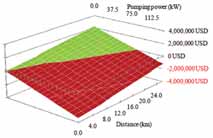
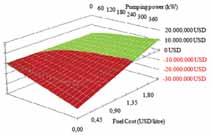
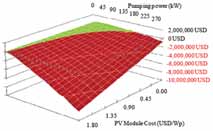
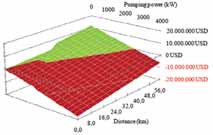
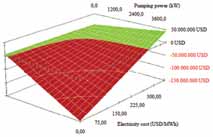
This software tool is useful for comparative analysis; it uses Standard Cost Investment values of any equipment and analyzes a large number of projects for wide-ranging variables. It presents a three-dimensional view. In one of the axes, the difference between the PVC of two possible solutions is shown. In the other axis a range of pumping power (kW), distance to electrical grid (km) and electricity prices ($/MWh) or fuel prices ($/liter) is shown. It is possible to determine the cost-effective limits in the comparison of each solution. It is also possible to obtain estimates of initial investment costs and the annual operational costs of each project, and to calculate PVC. Each solution for powering a pumping system is compared directly in these three-dimensional views.
The user can change parameters to get results for a particular area, to take into account the proximity of an electrical grid, or to consider variations in energy and fuel costs. Electrical losses in power lines are accounted for. In general, overhead lines are designed so that their ohmic losses do not exceed 7%, and this value is considered the reference.
Making the Choice
Photovoltaic vs. 13.2-kV grid extension
Figure 1 shows the cost-effective limits
of a PV solution versus a 13.2-kV grid
extension considering $250/MWh as
energy cost. In the light colored zone of
the chart, the PV solution is more economic.
For small pumping systems with
long distances from the well to the
existing grid, a PV solution is more
cost-effective. As the distance increases,
the pumping power at which a PV
solution is more cost-effective is higher.
For instance, when the pumping power
is 20 kW and the distance from the well
to the existing grid is greater than 8.5
km, a PV solution is more cost-effective
than a 13.2-kV grid extension.
At higher electricity prices, a PV solution is cost effective in more cases. Figure 2 shows the sensitivity of the best option to electricity cost in a case where the well is 5 km from the nearest grid. In this case, even if energy is free of charge, a PV solution is economically better than a grid connection up to 4.3 kW. If the price of electricity is $350/MWh, PV would be more costeffective up to 27 kW of pumping power.
Photovoltaic vs. 23-kV grid extension
A PV solution is more cost-effective
than a 23-kV grid extension project up
to 85 kW of pumping power and 27 km
from the well to the existing grid.
Figure 3 shows the sensitivity of the
best option to electricity cost in a case
where the well is 20 km from the nearest
grid. In this case, even if energy is
free, a PV solution is economically better
than a grid connection up to 24 kW.
Further analysis shows that at a given
distance, as the PV modules are cheaper,
the range of pumping power for
which the PV option is advisable is
greater. However, even if PV modules
were cost-free, a grid extension is more
favorable for projects involving pumping
power higher than 215 kW.
Photovoltaic vs. diesel powered
generation
At sites where grid extension is not feasible,
a pumping system can be driven
by a diesel genset or PV system. In
Figure 4, the light colored zone indicates
the area in which a PV stand-alone solution
(lower PVC) is recommended. For
instance, when diesel fuel price exceeds
$1.20/l, and considering the solar radiation
in the area, PV systems are more
cost-effective for pumping power requirements
up to 125 kW. Each case
study analyzed considers the fuel price
as an input. An annual inflation rate of
3% has been applied for its useful life.
Figure 5 shows the sensitivity of profitability of a PV solution based on the cost of thin-film PV modules, considering a fuel cost of $0.85/l. For power requirements greater than 185 kW, diesel generation is cheaper even if PV modules were cost-free. Considering the current costs of fuel, PV power for projects requiring up to 20 kW is economical.
66-kV grid extension vs. diesel powered
generation
SKM also analyzed projects based on
available electrical grid voltage levels versus
power from diesel gensets. An example
is shown here where the available
grid power is 66 kV. In this case, the
cost-effective limit is shown in Figure 6. For instance, when the grid is at a distance
of 40 km, it is more profitable to
install diesel generation up to 1.8 MW,
with prices of fuel and electricity being
$0.85/l and $250/MWh, respectively.
With a well located 30 km from a 66-kV overhead line, for example, a project using diesel power generation up to 1.35 MW implies lower PVC (Figure 7). At this distance and with a fuel cost of $0.85/l, an asymptote—a line that approaches a given curve arbitrarily closely but never touches—near $275/MWh is shown on the graph. If the electricity cost is higher than this value it will be more economical to install a diesel system.
Acknowledgement
The author is grateful for the support of
SKM’s Bruce Sinclair Scholarship and
Technology & Innovation Program,
which financed these studies.
Francisco Chueco is an electrical engineer and European Master in Renewable Energy, based in SKM’s Santiago, Chile, office. Published by permission of SKM, this is an abridged version of the original paper; readers may obtain a copy of the original, including all text, tables and references, by contacting mwhaley@skm.com.au.